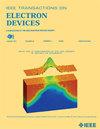具有增强的导态电流和低亚阈值摆幅的硅锗轴向异质结RFET
IF 2.9
2区 工程技术
Q2 ENGINEERING, ELECTRICAL & ELECTRONIC
引用次数: 0
摘要
本文在纳米尺度上研究了硅锗双栅可重构场效应晶体管(dg - rfet)。研究发现,Ge DG-RFET在提高Si DG-RFET的导通饱和电流(${I}_{\text {ON}}$)的同时,也会在低电压下产生双极电流,并且随着器件尺寸的减小而增大。通过分析DG-RFET的传导机理,研究Ge DG-RFET中双极电流的来源,我们提出了一种硅锗轴向异质结RFET (Si-Ge AH-RFET)。利用Sentaurus TCAD对其传导机制进行了详细研究,揭示了p -程序中独特的双隧道机制。仿真结果表明,与Si- dg - rfet相比,本文提出的Si- ge AH-RFET的n -程序性能提高了约8倍,p -程序性能提高了约11倍,亚阈值摆幅(SS)显著降低。同时,它在低电压下表现出与Ge DG-RFET相同的双极电流,并保持与Si DG-RFET相同的低漏电流(${I}_{\text {OFF}}$)。此外,与Si- DG-RFET相比,基于Si- ge ah - rfet的逆变器的传输延迟降低了约75%。本文章由计算机程序翻译,如有差异,请以英文原文为准。
Si–Ge Axial Heterojunction RFET With Enhanced On-State Current and Low Subthreshold Swing
This article investigates Si and Ge dual-gate reconfigurable field-effect transistors (DG-RFETs) at the nanoscale. It is found that while the Ge DG-RFET improves the on-state saturated current ( ${I}_{\text {ON} }$ ) of the Si DG-RFET, it also generates bipolar currents at low voltages, which increase as the device size decreases. By analyzing the conduction mechanism of the DG-RFET and examining the source of the bipolar currents in Ge DG-RFETs, we propose a silicon-germanium axial heterojunction RFET (Si-Ge AH-RFET). The conduction mechanism was investigated in detail by Sentaurus TCAD, which revealed a unique double-tunneling mechanism in the P-program. Simulation results show that compared with Si DG-RFETs, ${I}_{\text {ON} }$ of the proposed Si-Ge AH-RFET is improved by approximately eight times in the N-program and about 11 times in the P-program and the subthreshold swing (SS) is significantly reduced. Meanwhile, it does not exhibit the same bipolar currents at low voltages as the Ge DG-RFET and maintains the low leakage current ( ${I}_{\text {OFF} }$ ) as the Si DG-RFET. Furthermore, compared with the Si DG-RFET, the transmission delay of the Si-Ge AH-RFET-based inverter is reduced by approximately 75%.
求助全文
通过发布文献求助,成功后即可免费获取论文全文。
去求助
来源期刊

IEEE Transactions on Electron Devices
工程技术-工程:电子与电气
CiteScore
5.80
自引率
16.10%
发文量
937
审稿时长
3.8 months
期刊介绍:
IEEE Transactions on Electron Devices publishes original and significant contributions relating to the theory, modeling, design, performance and reliability of electron and ion integrated circuit devices and interconnects, involving insulators, metals, organic materials, micro-plasmas, semiconductors, quantum-effect structures, vacuum devices, and emerging materials with applications in bioelectronics, biomedical electronics, computation, communications, displays, microelectromechanics, imaging, micro-actuators, nanoelectronics, optoelectronics, photovoltaics, power ICs and micro-sensors. Tutorial and review papers on these subjects are also published and occasional special issues appear to present a collection of papers which treat particular areas in more depth and breadth.
 求助内容:
求助内容: 应助结果提醒方式:
应助结果提醒方式:


